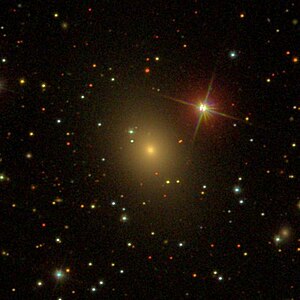NGC 7707
| Galaxy NGC 7707 |
|
|---|---|

|
|
| SDSS recording | |
| AladinLite | |
| Constellation | Andromeda |
|
Position equinox : J2000.0 , epoch : J2000.0 |
|
| Right ascension | 23 h 34 m 51.4 s |
| declination | + 44 ° 18 ′ 15 ″ |
| Appearance | |
| Morphological type | S0-: |
| Brightness (visual) | 13.6 mag |
| Brightness (B-band) | 14.6 mag |
| Angular expansion | 1.3 '× 1.1' |
| Position angle | 45 ° |
| Surface brightness | 14.1 mag / arcmin² |
| Physical data | |
| Redshift | 0.018493 ± 0.000113 |
| Radial velocity | 5544 ± 34 km / s |
|
Stroke distance v rad / H 0 |
(257 ± 18) · 10 6 ly (78.8 ± 5.5) Mpc |
| history | |
| discovery | William Herschel |
| Discovery date | October 24, 1786 |
| Catalog names | |
| NGC 7707 • UGC 12683 • PGC 71798 • CGCG 533-014 • MCG + 07-48-012 • 2MASX J23345141 + 4418141 • GC 4989 • H III 579 • h 2254 • NSA 151976 | |
NGC 7707 is an elliptical galaxy of Hubble type E / S0 in the constellation Andromeda on the northern sky . It is estimated to be 257 million light years from the Milky Way and about 95,000 ly in diameter.
The object was discovered by Wilhelm Herschel on October 24, 1786 .
